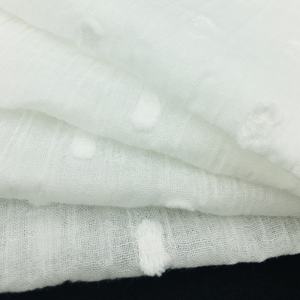Muslin Fabric: Uses and Types
Muslin fabric is used for making clothing, upholstery, and various household items.
Muslin is a versatile, lightweight, and breathable fabric made from cotton fibers. It is primarily used for making clothing such as dresses, shirts, and babywear, as well as upholstery, curtains, and other household items. This fabric is available in various textures and weaves, making it suitable for diverse applications.

The Cost of Muslin Fabric
Muslin cloth can be expensive due to its production process and high-quality raw materials.
The cost of muslin fabric varies depending on factors such as quality, origin, and production methods. High-quality muslin is made from long-staple cotton fibers, which can be more expensive than regular cotton. Additionally, the delicate weaving and finishing processes used to create muslin can contribute to its higher price.
Comparing Cotton and Muslin
The difference between cotton and muslin lies in their weaves, textures, and breathability.
While both cotton and muslin are made from natural cotton fibers, muslin has a looser, more open weave than regular cotton fabric. This results in a lightweight, breathable fabric that is perfect for hot climates and sensitive skin. In contrast, cotton fabric is available in various weaves and weights, making it suitable for a broader range of uses.
Disadvantages of Muslin Fabric
The main disadvantage of muslin fabric is its tendency to wrinkle easily.
Due to its loose weave and lightweight nature, muslin fabric is prone to wrinkling. This characteristic can make it less suitable for certain applications, such as formal wear or upholstery that requires a crisp appearance.
Muslin: Cotton or Polyester?
Muslin is a cotton fabric, not polyester.
Muslin fabric is made from natural cotton fibers, which are spun into yarn and then woven to create a lightweight, breathable fabric. Unlike polyester, which is a synthetic material, muslin is a natural, eco-friendly option.
Muslin Fabric in Summer
Muslin cloth is good for summer due to its breathability and lightweight nature.
The open weave and lightweight qualities of muslin fabric make it an ideal choice for hot summer months. It allows air to circulate freely, helping to keep the wearer cool and comfortable.
Muslin vs. Cotton
Muslin cloth is like cotton but with a looser, more open weave.
While both muslin and cotton fabrics are made from cotton fibers, muslin has a distinctive open weave that sets it apart. This loose weave makes muslin lighter and more breathable than standard cotton fabric.

Muslin and Silk
Muslin is not pure silk; it is made from cotton fibers.
Muslin fabric is created from cotton fibers and does not contain any silk. However, it can have a smooth, soft texture that may resemble that of silk, depending on the quality and finish of the fabric.
Dhaka Muslin and Bangladeshi Tradition
Dhaka muslin is a fine, delicate muslin fabric historically produced in the Dhaka region of present-day Bangladesh.
Dhaka muslin is a traditional fabric of Bangladesh, known for its exceptional quality and craftsmanship. It was highly sought after for its fine, delicate texture and intricate designs.
Import Ban on Dhaka Muslin in England
The import of Dhaka muslin was banned in England during the 18th and 19th centuries to protect the local textile industry.
British manufacturers, threatened by the popularity and quality of Dhaka muslin, lobbied for import restrictions. As a result, the British government imposed bans and high tariffs on the import of Dhaka muslin to safeguard the domestic textile industry. These protectionist measures stifled the growth of the Dhaka muslin industry and ultimately contributed to its decline.
Using Muslin Cloth Every Day
You can use muslin cloth every day for various purposes, such as clothing, baby care, and household items.
Muslin fabric is versatile and durable, making it suitable for everyday use. It is commonly used for making clothing, baby blankets, swaddling cloths, and burp cloths, as well as household items like tea towels and reusable produce bags. Its breathable and lightweight nature makes it comfortable and practical for daily use.
Muslin Fabric and Shrinkage
Muslin does shrink when washed, especially if it has not been pre-treated.
Like most cotton fabrics, muslin can shrink when washed, particularly if it has not been pre-shrunk or pre-treated. To minimize shrinkage, it is advisable to wash muslin in cold water and allow it to air dry. If using muslin fabric for sewing projects, pre-washing the fabric before cutting and sewing can help prevent future shrinkage.
Muslin Fabric Thickness
Muslin cloth can be thin or thick, depending on the weave and weight of the fabric.
The thickness of muslin fabric can vary widely, depending on the specific weave and weight used in its production. Finer, lightweight muslin is often thin and delicate, while heavier, more densely woven muslin can be thicker and more substantial. The thickness of the muslin fabric can affect its breathability, drape, and durability, so it is essential to choose the appropriate thickness for the intended use.


Pingback: Some Properties of Muslin Fabric - BlainesApparel.com
Pingback: How Muslin Cotton Became King of Fabric Softness - BlainesApparel.com
Pingback: Advantages and Disadvantages of Muslin Fabric: A Comprehensive Guide - BlainesApparel.com
Pingback: Muslin Fabric Composition, Pricing, Benefits, Quality, and Popularity - BlainesApparel.com